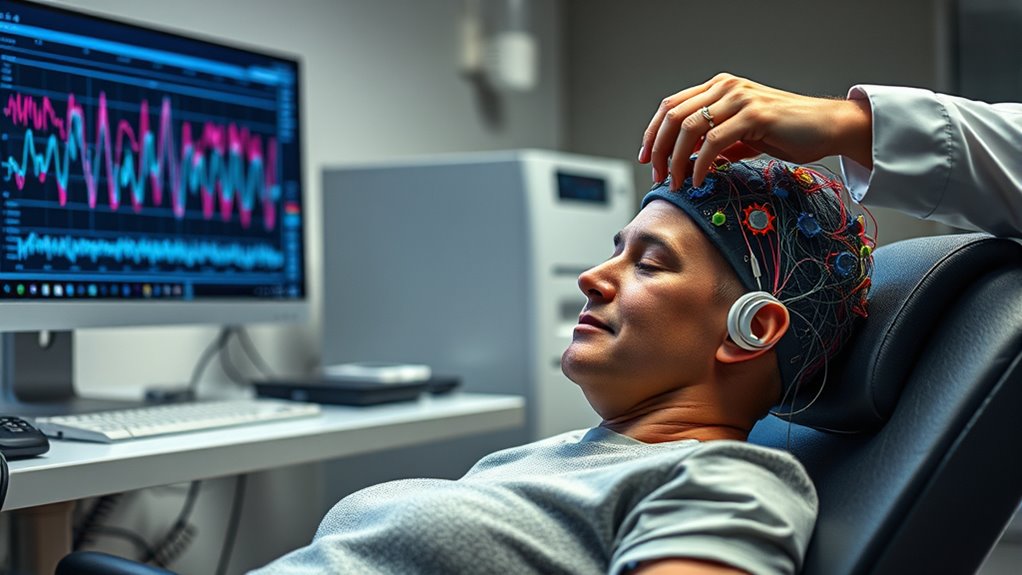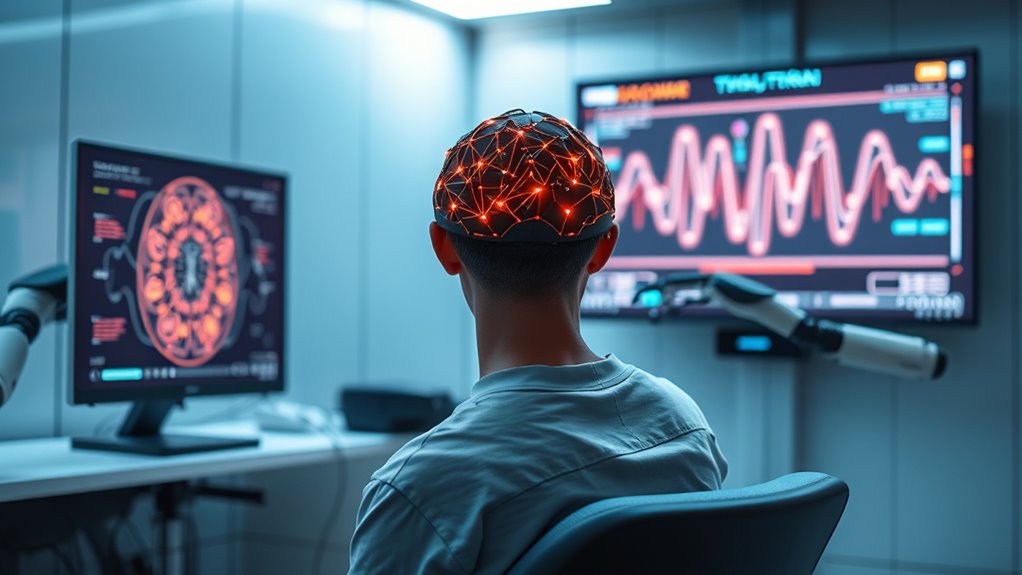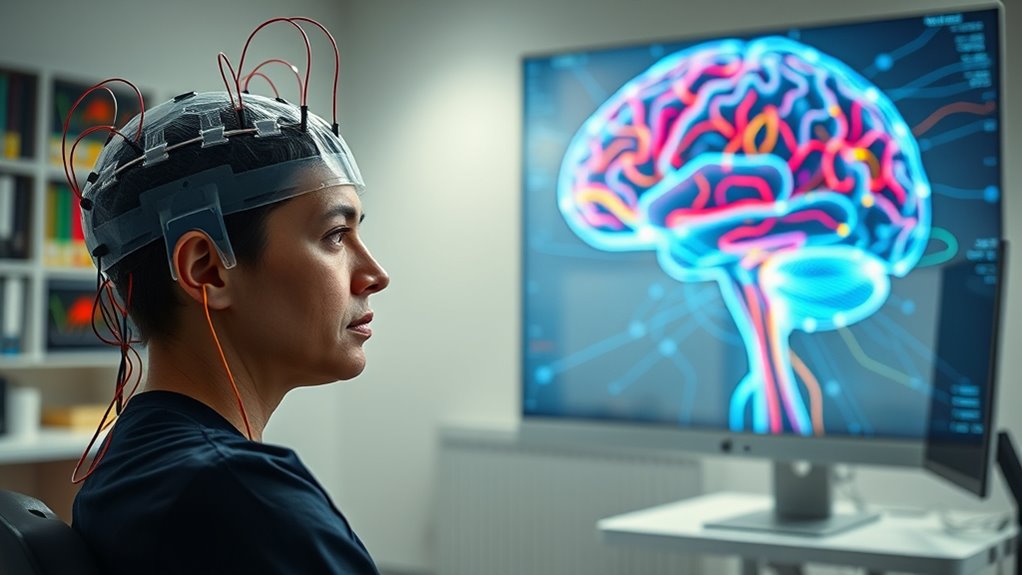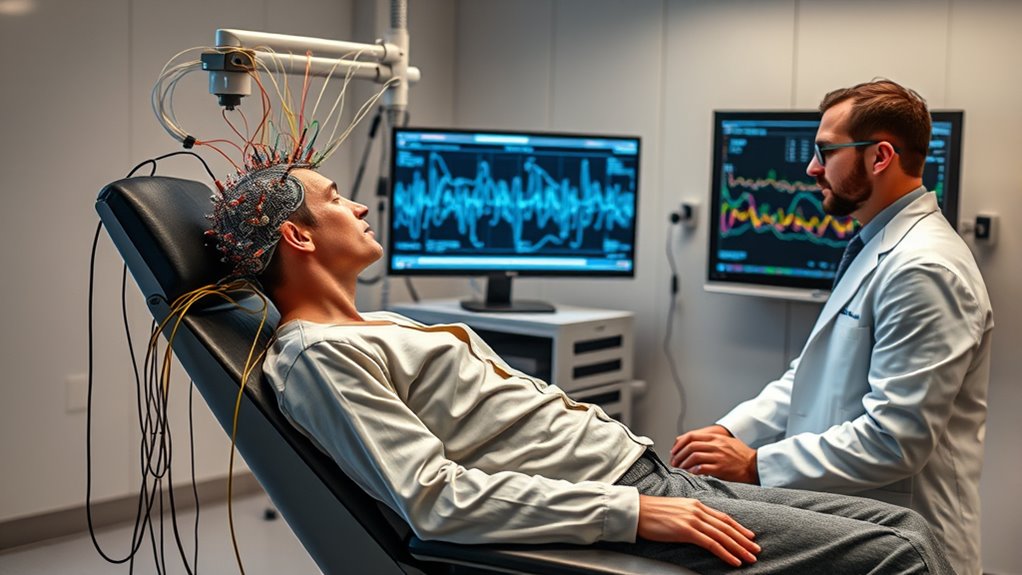Brain-computer interfaces are revolutionizing stroke rehab by enabling direct brain-to-device communication, helping restore movement and promote neural recovery. Advances include flexible electrodes, wireless systems, and AI-enhanced signal decoding that make devices more portable, accurate, and responsive. Personalized protocols and immersive technologies like virtual reality improve engagement and outcomes. While challenges remain, ongoing innovations promise safer, more effective therapies—discover more about how these breakthroughs can support your recovery journey.
Key Takeaways
- Recent BCI innovations include flexible electrodes, wireless systems, and miniaturized devices for portable stroke rehabilitation.
- AI-driven signal processing enhances real-time decoding of neural activity, improving responsiveness and accuracy.
- Hybrid BCIs combining EEG with other modalities like fNIRS provide richer brain data for personalized therapy.
- Adaptive, user-centered BCI protocols promote neuroplasticity and faster motor recovery through tailored interventions.
- Clinical research demonstrates BCIs’ effectiveness in improving motor function, engagement, and long-term skill retention post-stroke.
Overview of Brain-Computer Interfaces in Stroke Recovery

Brain-Computer Interfaces (BCIs) have emerged as a promising tool in stroke recovery by directly connecting the brain to external devices. They detect electrical signals from your brain and translate them into commands that control computers, robotic limbs, or other assistive tools. This technology bypasses damaged neural pathways, helping restore movement and communication skills. BCIs can be invasive, involving electrodes implanted in the brain, or non-invasive, using sensors placed on your scalp. They offer real-time feedback, allowing you to learn how to regain control over affected muscles or functions. As a result, BCIs provide a new pathway for rehabilitation, empowering you to participate actively in your recovery process and potentially regain independence more quickly. Both invasive and non-invasive approaches require careful ethical considerations to ensure safety and privacy. Additionally, advancements in data analysis and machine learning have improved the accuracy and responsiveness of BCI systems, making them more effective in clinical settings. Incorporating neural signal processing techniques has further enhanced the precision and usability of these systems, especially as research continues to address AI security concerns related to data privacy and system robustness. Moreover, the integration of high-resolution electrodes is enhancing the quality of neural recordings, leading to better rehabilitation outcomes.
Recent Technological Innovations in BCI Devices

Recent advances in BCI devices have considerably enhanced their effectiveness and user accessibility. New electrode materials, such as flexible, lightweight, and biocompatible sensors, improve signal quality while reducing discomfort. Wireless technology has eliminated cumbersome cables, making devices more portable and user-friendly. Advances in machine learning algorithms enable real-time decoding of complex brain signals, increasing accuracy and responsiveness. Additionally, hybrid systems now combine EEG with functional near-infrared spectroscopy (fNIRS), providing richer data and better insights into brain activity. Miniaturization of hardware allows for discreet, wearable devices that can be used outside clinical settings. Emerging electrode materials significantly contribute to improved comfort and performance. Incorporating insights from Bitcoin IRA management strategies, such as regular monitoring and diversification, can enhance the long-term sustainability of BCI technologies. These innovations make BCIs more practical for daily use, fostering greater independence and engagement for stroke survivors in their recovery journey. To further optimize device usability, ongoing research focuses on user-centered design to tailor solutions to individual needs. Additionally, integrating adaptive algorithms can help personalize therapy and improve outcomes over time.
Enhancing Motor Function Through BCI-Driven Rehabilitation

You can improve motor recovery by using neural signal decoding strategies that translate brain activity into precise commands. These strategies allow for more accurate and responsive BCI systems tailored to your needs. By developing customized therapy protocols, your rehabilitation becomes more effective, targeting specific motor impairments for better outcomes. Incorporating advanced tuning techniques from automotive customization can also inspire innovative approaches to optimize BCI performance. Additionally, utilizing personalized device naming inspired by preppy dog names can enhance user engagement and motivation during therapy. Recognizing the importance of neural signal decoding techniques can further refine BCI responsiveness and effectiveness.
Neural Signal Decoding Strategies
Decoding neural signals accurately is essential for translating brain activity into meaningful commands that can drive motor recovery in stroke patients. You need effective strategies to interpret complex EEG or invasive signals, distinguishing relevant motor intentions from background noise. Techniques like machine learning algorithms, including support vector machines and deep learning models, help improve decoding accuracy by identifying patterns linked to movement attempts. Feature extraction methods, such as spectral analysis and time-frequency domain analysis, highlight critical signal components. Real-time processing is vital so that decoded signals can immediately control assistive devices or stimulate muscles. Continual refinement of these strategies enhances the reliability of neural signal interpretation, making BCI-driven rehabilitation more responsive and effective. Ultimately, sophisticated decoding strategies are the backbone of translating neural intent into functional motor improvements.
Customized Therapy Protocols
Customized therapy protocols leverage brain-computer interfaces to tailor rehabilitation exercises precisely to each patient’s neural signals and motor deficits. This personalization boosts engagement and accelerates recovery by focusing on specific neural pathways needing retraining. BCI systems analyze real-time brain activity, adjusting tasks to match your progress. This adaptive approach ensures you receive ideal stimulation, promoting neuroplasticity. Here’s a quick overview:
| Feature | Benefit |
|---|---|
| Real-time Adjustment | Personalized challenge levels |
| Neural Feedback Integration | Targets affected motor areas |
| Adaptive Training | Maximizes recovery potential |
Integration of Artificial Intelligence With BCI Systems

Integrating artificial intelligence with BCI systems can profoundly improve how signals are processed and interpreted. You’ll see adaptive machine learning algorithms that fine-tune responses in real-time, making rehabilitation more effective. This integration leads to personalized strategies that better suit each patient’s unique recovery needs. Moreover, cognitive enhancement techniques such as ECU remapping and performance upgrades can be analogous to optimizing BCI systems for enhanced functionality and responsiveness.
Enhanced Signal Processing
Advances in artificial intelligence have markedly enhanced signal processing in brain-computer interface (BCI) systems for stroke rehabilitation. You now benefit from more accurate detection of neural signals, even amid noise and artifacts. AI algorithms can quickly distinguish relevant brain activity patterns, improving the system’s responsiveness. This precision allows for better translation of neural signals into commands, facilitating smoother control of assistive devices or feedback mechanisms. Enhanced signal processing reduces latency, making interactions more natural and effective. As a result, your therapy sessions become more efficient, encouraging engagement and motivation. By refining how BCI systems interpret brain signals, AI-driven approaches help you regain motor functions faster and with greater confidence, ultimately supporting your recovery journey.
Adaptive Machine Learning Algorithms
Building on improved signal processing, adaptive machine learning algorithms take your brain-computer interface (BCI) systems to the next level by dynamically adjusting to your unique neural patterns. These algorithms analyze real-time data, learning from your neural signals to improve accuracy and responsiveness continuously. They can distinguish subtle changes in brain activity, minimizing errors and adapting to fluctuations caused by fatigue or stress. By refining their models over time, they enhance the system’s ability to interpret your intentions, making control more intuitive. This adaptability reduces the need for manual recalibration, streamlining your rehabilitation experience. As a result, your BCI becomes more reliable and personalized, helping you regain motor functions more efficiently and comfortably during stroke recovery.
Personalized Rehabilitation Strategies
By harnessing artificial intelligence, personalized rehabilitation strategies tailor BCI systems to your unique neural patterns and recovery needs. AI analyzes real-time brain signals to optimize therapy, making adjustments as you progress. This approach guarantees targeted interventions that adapt to your evolving capabilities. Here’s how it works:
- Collects detailed neural data specific to your stroke.
- Analyzes patterns to identify strengths and weaknesses.
- Customizes stimulation and feedback for maximum effectiveness.
- Continuously refines strategies based on your ongoing responses.
This integration creates a dynamic, responsive rehab plan that accelerates recovery and enhances engagement. By focusing on your individual brain activity, AI-driven BCI systems provide precision therapy, making your rehabilitation more efficient and personalized.
Patient-Centered Design and Usability Improvements

Designing brain-computer interfaces (BCIs) with your needs in mind is essential for effective stroke rehabilitation. When developers prioritize usability, you benefit from intuitive controls that fit your abilities and limitations. Simplifying interfaces reduces frustration and encourages consistent use, which is crucial for progress. Incorporating feedback from users like you helps identify pain points and tailor features for comfort and accessibility. Adjustable settings allow you to customize the device, making it easier to integrate into daily routines. Clear visual and auditory cues improve communication between you and the system, boosting confidence and motivation. Overall, patient-centered design ensures BCIs are not only effective but also engaging and easy to use, ultimately enhancing your rehabilitation experience and outcomes. Additionally, engaging in hackathons, especially those focused on healthcare innovations, can accelerate the development of user-friendly BCI solutions by fostering collaboration and creative problem-solving.
Clinical Trials and Evidence Supporting BCI Effectiveness

Recent clinical trials have provided strong evidence that brain-computer interfaces can markedly improve motor recovery in stroke patients. These studies demonstrate significant benefits through various approaches:
- Enhanced motor function, with some patients regaining voluntary movement faster than traditional therapies.
- Improved neuroplasticity, showing increased brain reorganization post-BCI intervention.
- Higher patient engagement, leading to better adherence and motivation during rehab.
- Long-term retention of motor skills, indicating durable benefits from BCI-assisted therapy.
- As the field advances, innovations like electric bus technology and the VW ID. Buzz are inspiring new applications of sustainable transportation models that could influence future mobility solutions beyond traditional vehicles. Additionally, ongoing research emphasizes the importance of clinical trial evidence to validate these emerging techniques and ensure their safety and efficacy. A focus on neuroplasticity is crucial, as it underpins the brain’s ability to adapt and recover following injury, making it a key target for many BCI therapies. Moreover, understanding the mechanisms of brain reorganization can help optimize rehabilitation strategies and improve patient outcomes. Furthermore, the integration of privacy considerations is essential to protect patient data as BCI technologies become more widespread.
Challenges and Limitations of Current BCI Technologies

While clinical trials highlight the promising potential of brain-computer interfaces in stroke rehabilitation, several challenges hinder their widespread adoption and effectiveness. One major hurdle is signal variability, which makes it difficult to maintain consistent control and accurate interpretation of brain signals. This can lead to unreliable device responses and frustration during therapy. Additionally, current BCI systems often require extensive calibration and setup time, limiting practicality for daily use. The high cost of equipment and specialized training also create barriers for many clinics and patients. Safety concerns, such as potential infections from invasive devices or unintended neural stimulation, further complicate implementation. Finally, individual differences in brain anatomy and stroke severity mean that one-size-fits-all solutions rarely work, requiring personalized adjustments that are time-consuming and complex. Device customization remains a critical factor for improving BCI efficacy.
Future Directions and Potential Developments in Stroke Rehabilitation

Advancements in neural engineering and machine learning are paving the way for more effective and user-friendly brain-computer interfaces in stroke rehabilitation. These innovations will likely transform recovery by enabling personalized, adaptive therapies. You can expect developments such as:
- Integration of AI algorithms for real-time, precise decoding of neural signals
- Enhanced electrode designs for improved comfort and signal quality
- Closed-loop systems that adjust stimulation based on patient progress
- Combining BCIs with virtual reality for immersive, engaging rehab sessions
These advancements aim to make BCIs more accessible, efficient, and tailored to individual needs. As technology progresses, you’ll benefit from faster recovery times, increased independence, and a more seamless integration of neural interfaces into daily life.
Frequently Asked Questions
How Do BCI Systems Personalize Stroke Rehabilitation Programs?
You might wonder how BCI systems tailor stroke rehab programs. They personalize treatment by analyzing your brain signals in real-time, detecting specific patterns linked to your movement intentions. This data helps adjust therapy dynamically, focusing on your unique neural responses. As you use the system, it learns from your progress, optimizing exercises and feedback to enhance recovery. This personalized approach makes rehabilitation more effective and engaging for you.
What Are the Costs Associated With Implementing BCI Technology in Clinics?
You might think implementing BCI technology in clinics is straightforward, but the costs can be significant. Equipment expenses, such as high-tech sensors and computers, often run into thousands of dollars. Training staff and ongoing maintenance add to the bill. While initial investments are high, many clinics believe that improved patient outcomes and long-term benefits justify the costs, making BCI a promising addition to stroke rehab.
How Long Does It Typically Take to See Improvements With BCI Therapy?
You’ll typically start noticing improvements in your motor skills within a few weeks of beginning BCI therapy, but it varies based on your condition and consistency. Some patients see progress as early as 4 to 6 weeks, while others might take longer. Regular sessions combined with your commitment can accelerate recovery, and your healthcare team will monitor your progress to adjust the treatment plan as needed.
Are There Any Risks or Side Effects From Using BCI Devices?
You might worry that using BCI devices could cause serious side effects, but actually, they’re designed with your safety in mind. Most people experience minimal risks, like slight discomfort or skin irritation from electrodes. Serious issues are rare. You should always work with trained professionals, follow instructions carefully, and report any unusual sensations. Overall, BCI devices are safe tools that can help you recover without causing significant harm.
How Accessible Are Bci-Based Treatments for Patients in Remote Areas?
You might wonder how accessible BCI-based treatments are for those in remote areas. While these devices are becoming more common, access still depends on local healthcare infrastructure and technology availability. Telemedicine and mobile clinics help bridge gaps, but limitations exist in some regions. As technology advances and costs decrease, you could see greater reach, making BCI treatments more available to everyone, regardless of location.
Conclusion
As you explore the world of BCI in stroke rehab, it’s clear that technology is moving mountains to help you regain motor function. With rapid innovations and AI integration, you’re on the cusp of breakthroughs that could change your recovery journey. While challenges remain, the future looks bright. Keep in mind, the early bird catches the worm—staying informed and engaged can turn these advancements into real progress for your healing path.









